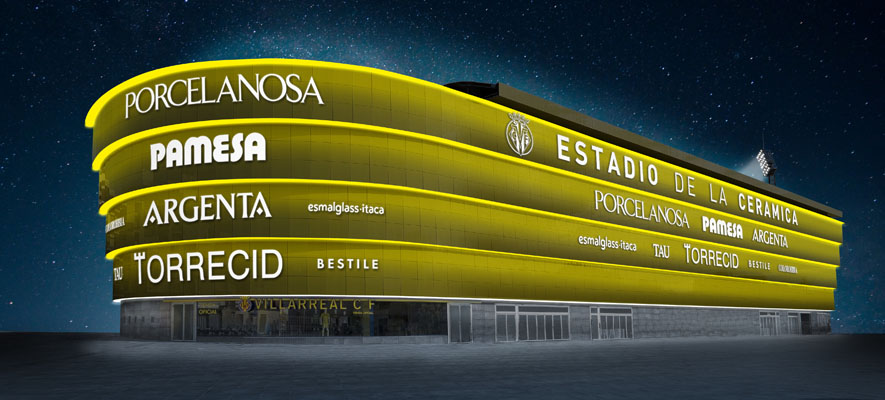- February 13, 2017
- Posted by: SportsV
- Categories: Case Studies, Featured Articles, Features, Home News, Industry News, News

Spanish La Liga football club, Villarreal CF, unveiled their newly re-named ‘Estadio de la Cerámica’ before last month’s home game against Barcelona; the stadium having previously been known as El Madrigal since the 1920’s.
The companies that form part of the ‘Estadio de la Cerámica’ are: PAMESA, PORCELANOSA, ARGENTA CERÁMICA and TORRECID as Main Sponsors; and TAU CERÁMICA, BESTILE, ESMALGLASS-ITACA and COLOROBBIA as Official Sponsors. All hail from the ceramics industry, thus the name, Estadio de la Cerámica “The Ceramic Stadium”.
Villarreal Owner and Chairman, Fernando Roig, who made his fortune in ceramics and personally led the project, said:
This is only the first 25 percent. We are at the beginning of what we want the stadium to be and we will continue to improve it. It is a project with the philosophy of Villarreal at its heart. Everyone wins with this remodelling. Including the sponsors, as the ceramic facade to the stadium will be a permanent exhibition and showcase of their wares.
The ‘Estadio de la Cerámica’ is the home ground of Villarreal CF. The stadium has a capacity of 23,500 and the pitch dimensions are 105 x 68m. The home of the Yellows is located next to the Plaza del Labrador (Labrador square) in Vila-real and, interestingly, since its opening in 1923, it has never been relocated. Parallel to the Mediterranean, which is just 5km away, the ‘Estadio de la Cerámica’ stands at an altitude of 50m above sea level.
The stadium was originally opened on June 17, 1923, and was called ‘Campo de Villarreal‘, but only two years later it came to be known as ‘El Madrigal‘, a name that referred to the rural site the facility was built on, which went by the same name. The stadium was inaugurated with a match between CD Castellón and SD Cervantes FC, two teams from the capital of the province.
El Madrigal underwent its first extension in the summer of 1952, taking advantage of the off season. That remodelling also saw the change of the pitch dimensions to match the measurements of the Olympic Stadium of Helsinki, which hosted the Olympic Games that year, and became the standard for all football clubs. Thus the pitch size increased from 95 x 50m to 104 x 65m.
In the 1960’s, Villarreal built a small, covered stand, and in the 1971/72 season the original South Stand (Fondo Sur) was set up. The Main Stand was demolished on July 19 1988, so that a bigger one could be built, which eventually opened on March 8, 1989, with a friendly match against Atlético de Madrid.
To mark the club’s 75th anniversary, the most significant remodelling of the stadium was undertaken, the results of which gave us the venue we know and love today. The South Stand (Fondo Sur) was demolished on May 22, 1998, and construction of the new covered Main Stand (Tribuna) began, as well as the amphitheatre, the Preferential Stand (Preferencia) and the North Stand (Fondo Norte). The project was completed for the start of the 1999/2000 season.
Believe it or not, the changing rooms have had four different locations since the ground was inaugurated. Until the 1935/36 season, the changing rooms occupied the south-east area of the stadium. From that date until the late 60s, they moved to the north-east part of the pitch. Then, with the inauguration of the new Main Stand (Tribuna) in 1989, they were located in the south-west corner until the final remodelling, where they were relocated to their current location just below the centre of the Main Stand (Tribuna).
Finishing touches
After undergoing several renovations, the last touches to the stadium were implemented in the summer of 2008 with the construction of the Away Stand (Grada Visitante), right above the North Stand (Fondo Norte), allowing away fans to enjoy the game in peace. With a capacity of almost 2,300, this was an exemplary remodelling.
Taking advantage of the construction of the Away Stand (Grada Visitiante), Villarreal added 27 new ‘Blue Corporate Boxes’ (Els Casals Blaus). These boxes are located in the upper part of the North Stand (Fondo Norte) and are divided into three different types – those that host 17, 22 or 23 people. Just like the stadium’s ‘Yellow Corporate Boxes’ (Els Casals Grocs), these boxes are equipped with air conditioning, a television broadcasting the game with replays, catering, individual seats and independent access.
There are also 30 ‘Yellow Corporate Boxes’ spread along the upper area of the Main Stand, which can be accessed at the corner of the South Stand (Fondo Sur) via three high speed elevators and there is a parking space per box. Out of the 30 boxes, 2 have capacity for 12 people each, 23 can accommodate 16 people and the other 5 are available for groups of 20 people.
In order to improve visibility, Villarreal CF remodelled the entire bench area in the summer of 2013, changing it to a similar style used in some of the English Premier League (EPL) stadiums. Thus, the area has increased in size and height, occupying a small part of the Main Stand (Tribuna). Spacious and comfortable, the expansion also led to the extension of the roof of the Main Stand to provide better protection for both fans and players.
Cutting-edge technology
Villarreal became the first club in Spain to install a mixed artificial and natural grass pitch. The Submarine committed fully to this cutting-edge technology, choosing to use this surface for the three most important pitches: the main stadium, the First Team Training Ground pitch and the Mini Stadium (Mini Estadi), that holds 5,000 spectators, at the Villarreal CF Training Ground (Ciudad Deportiva).
The surface, a ‘Desso GrassMaster‘, is a hybrid grass system in which synthetic fibres are injected into the soil allowing the roots of the natural grass to curl around and root the artificial fibres, providing a more stable and lasting field of play.
The unveiling of ‘Estadio de la Cerámica’
On January 8, 2017, Villarreal CF unveiled the new name of its stadium: ‘Estadio de la Cerámica’ (The Ceramic Stadium), as a symbol that identifies and is representative of the province of Castellón, proudly becoming an ambassador for one of the best products the region produces and a showcase of this extraordinary material. In addition, with this new initiative, the club has generated a new source of revenue as many ceramic tile companies from the province decided to join the project as partners, obtaining brand presence in various advertising spaces in the stadium with the corresponding national and international visibility.
The South Stand (Fondo Sur) of the ‘Estadio de la Cerámica’ shines with a façade completely covered with high gloss, yellow porcelain stoneware, in traditional Villarreal CF fashion. A material, of great aesthetic elegance, that underwent a state-of-the-art polishing process. Ceramic tiles of the highest quality with magnificent features such as thermal insulation and excellent solar and acoustic protection. 2,000 square metres of this stoneware have been fitted with the ventilated ceramic façade system. All with a double fixation system for maximum security.
The front is illuminated with a modern and revolutionary LED light system. More than 500 light points make for amazing results. It uses a digitally controlled system that allows changes in colours and effects, to be able to alternate between different designs and styles. A formula of high performance and low consumption lighting also have an impact on energy savings.
The surroundings of the ‘Estadio de la Cerámica’ have also been transformed, as a new, diaphanous square has been built, with ceramic pavement. From the square, fans have a fantastic view of the stadium’s new façade and it will also serve as a meeting point and space for activities for all fans gearing up for matches. With this new construction, security has also been notably improved, as there will be better fluidity in the circulation of fans in the surrounding areas and in the evacuation routes from the pitch. In addition, all Vila-real citizens benefit from this new space as it is ready to host all kinds of events, as there is a warehouse and changing room area located at the stadium’s base level.
Source: VillarealCF.es/en

